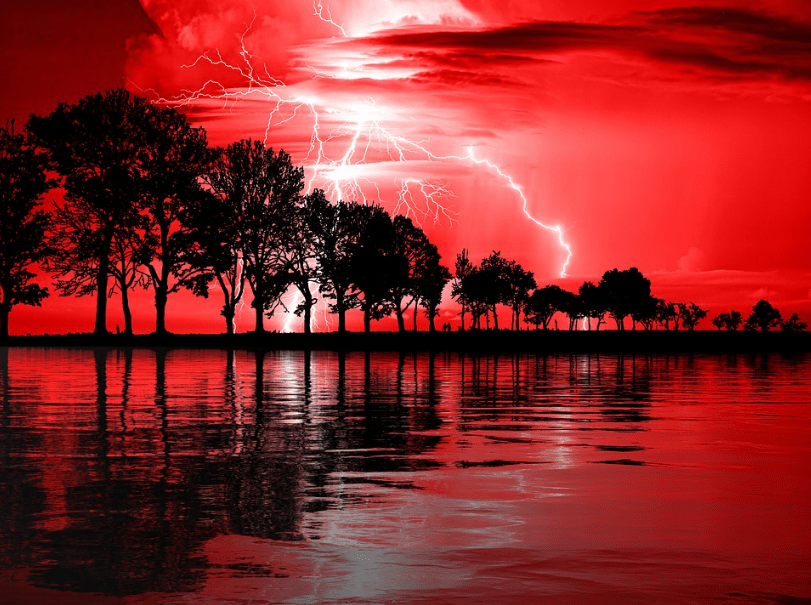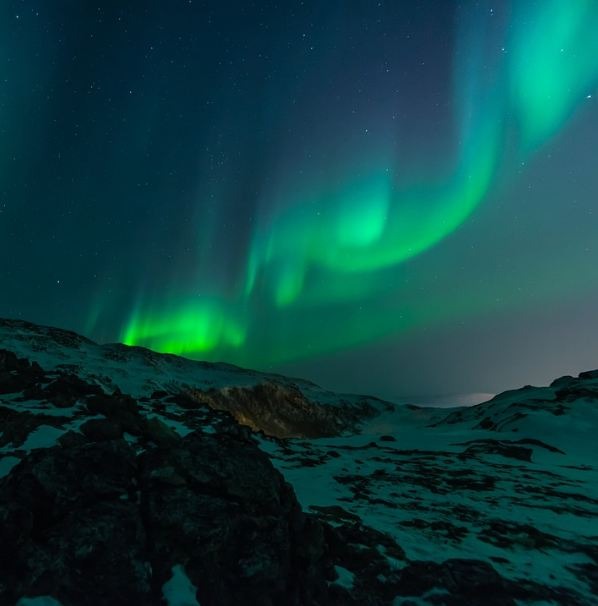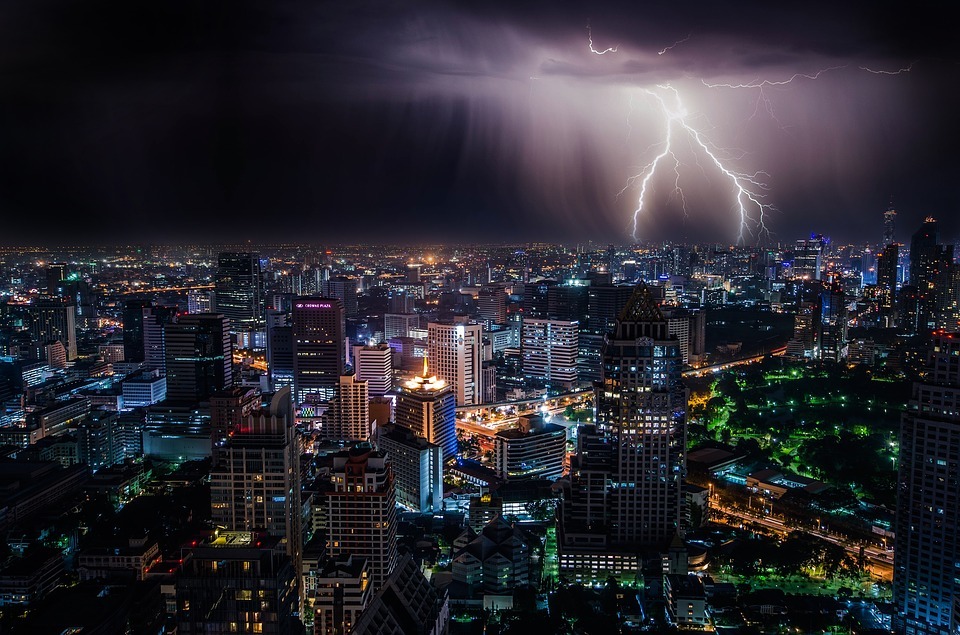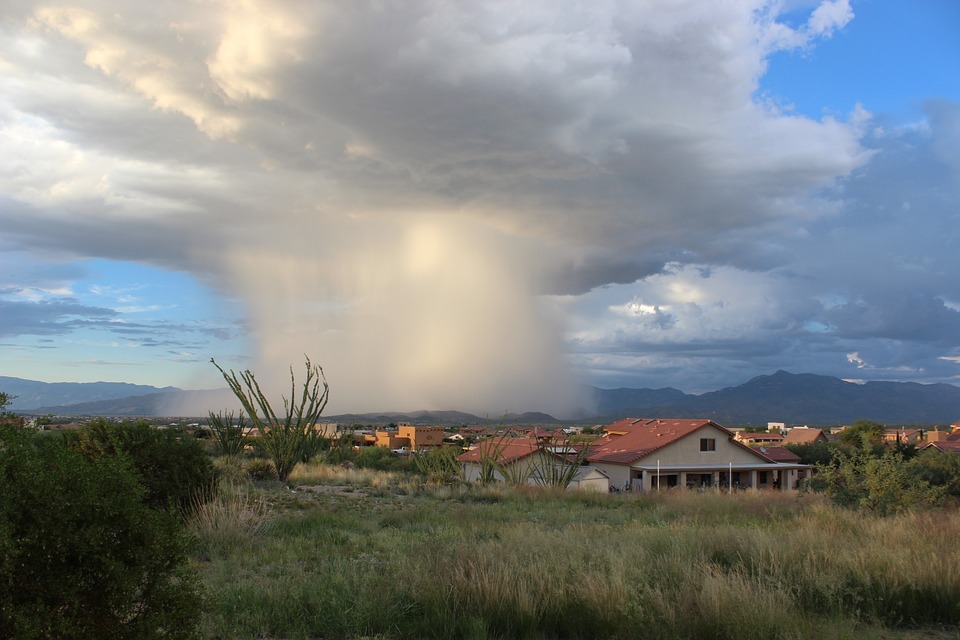What Causes a Polar Vortex?
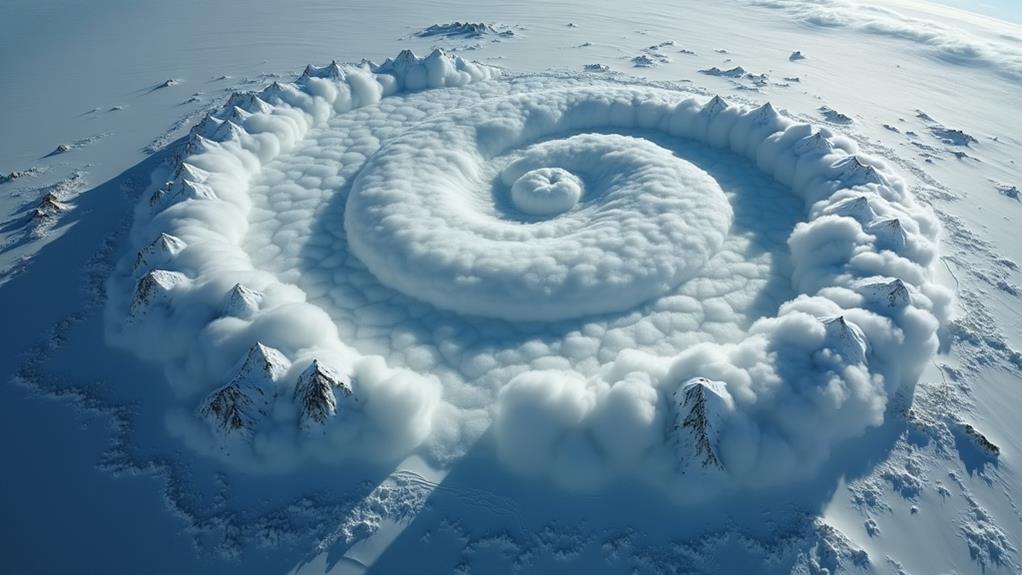
You encounter a polar vortex when a vast area of low pressure and icy air encircles the Earth's poles. It's primarily driven by differences in temperature between the Arctic and mid-latitudes, which create fast-flowing winds known as the polar jet stream. When this jet stream weakens or becomes unstable, cold Arctic air can push southward, leading to extreme cold snaps. Climate change can exacerbate this instability, making such events more severe. To understand how this impacts weather patterns and what other factors come into play, just keep exploring.
Key Takeaways
- A polar vortex is a massive low-pressure area with frigid air encircling Earth's poles, strongest in the winter.
- Strong temperature differences between the Arctic and mid-latitudes create and stabilize the polar jet stream.
- Climate change weakens temperature differences, destabilizing the polar jet stream and allowing Arctic air to move southward.
- High-pressure systems around the vortex influence its stability, affecting the distribution of cold air.
- Sudden stratospheric warming events often destabilize the polar vortex, leading to significant weather changes.
Definition of a Polar Vortex
A polar vortex is a massive area of low pressure and frigid air that encircles Earth's poles, most prominently seen during the winter months in the Northern Hemisphere. This phenomenon is characterized by strong, fast westerly winds in the stratosphere, typically located 10-30 miles above the North Pole. These winds enclose a pool of extremely cold air, leading to distinct weather patterns.
The polar vortex's structure includes both stratospheric and tropospheric components. The stratospheric part is strongest in winter, while the tropospheric vortex persists year-round. The temperature gradient between the Arctic's cold air and warmer mid-latitudes plays an essential role in its formation. This gradient, combined with low pressure in the Arctic and high pressure systems elsewhere, shapes the vortex's behavior.
During winter months, the polar vortex strengthens, expanding southward and affecting mid-latitude weather patterns. This expansion can cause significant shifts, bringing cold air and storms to regions unaccustomed to such conditions. Atmospheric dynamics, including the balance between high and low-pressure systems, influence the polar vortex's behavior, making it a vital factor in understanding winter weather in the Northern Hemisphere.
Temperature Differences and Polar Vortex
Understanding the behavior of the polar vortex requires examining the temperature differences between the polar regions and mid-latitudes. These differences are essential because they create a strong polar jet stream, which acts as a barrier, keeping the cold Arctic air contained within the polar vortex. When this temperature difference is stable, the polar jet stream remains strong and the polar vortex is intact.
However, several factors can disrupt this balance. Here are three key points to take into account:
- Climate change: Significant warming in the Arctic reduces the temperature difference between the polar regions and mid-latitudes. This weakened gradient can destabilize the polar jet stream.
- Weaker jet streams: A weaker polar jet stream allows Arctic air to move southward, leading to extreme weather events in mid-latitude areas.
- Pressure areas: Shifts in high and low-pressure areas due to reduced temperature gradients can further disrupt the polar vortex, exacerbating instability.
When the polar vortex weakens, it's more prone to disturbances, causing cold Arctic air to spill into lower latitudes. This can lead to extreme weather events, such as severe cold snaps and snowstorms, even in regions that typically experience milder winters. Understanding these interactions is critical for predicting and preparing for such events.
Role of the Polar Jet Stream
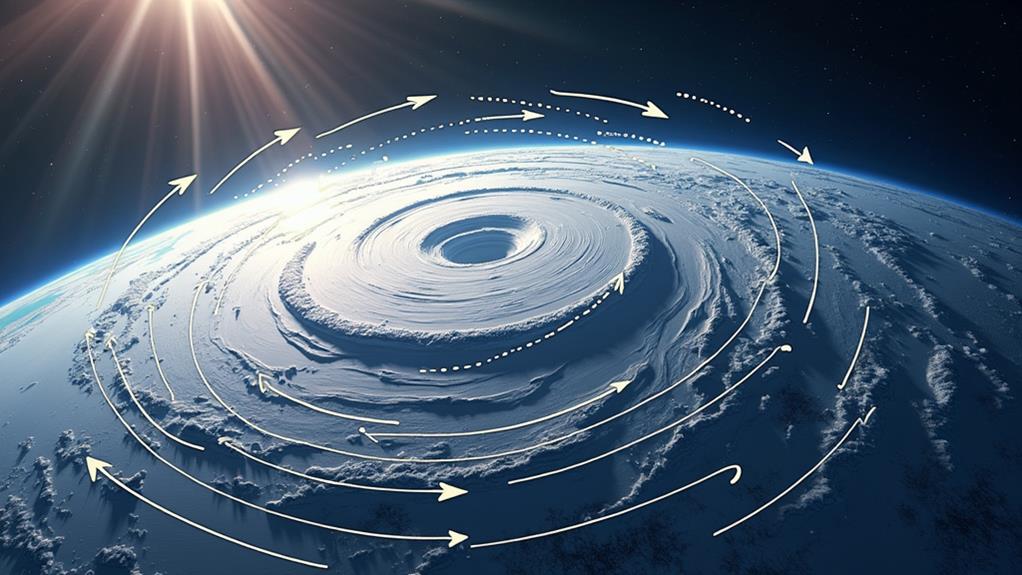
The polar jet stream, a fast-flowing band of winds in the upper atmosphere, plays a vital role in modulating global weather patterns. You'll find this jet stream circumnavigating the Earth at mid-latitudes, typically 5 to 9 miles above the surface. It acts as a barrier, containing cold Arctic air within the polar vortex. This is due to the strong temperature gradients between the polar and mid-latitude regions, which create a stable polar jet stream.
When the polar vortex weakens, the polar jet stream becomes more meandering. This allows cold Arctic air to push southward into lower latitudes, resulting in extreme winter weather events. You might experience colder temperatures and heavy snowfall in regions that usually enjoy milder winters. The behavior of the polar jet stream is influenced by Earth's rotation and the temperature gradients between the Arctic and its surrounding areas.
Climate models show that a weakened polar jet stream leads to increased weather variability. Understanding the polar jet stream's role in weather patterns is vital for predicting and preparing for these changes. By monitoring its behavior, you can better anticipate significant impacts on your local weather.
Pressure Systems and Polar Vortex Dynamics
When examining the dynamics of a polar vortex, pressure systems play an integral role in its behavior. The polar vortex is fundamentally a large area of low pressure filled with cold air, typically centered around the North Pole during winter. This system is maintained by the polar jet stream, which relies on the temperature difference between mid-latitudes and polar regions to keep that cold air contained.
High-pressure systems are vital in this dynamic. They balance the atmospheric forces by distributing air towards lower pressure zones, including the polar vortex. When these high-pressure systems shift, it can lead to the destabilization of the polar jet stream. This destabilization allows Arctic air to spill into lower latitudes, causing significant weather changes.
Consider these key points:
- Temperature Difference: The polar jet stream is powered by the stark temperature difference between mid-latitudes and the polar regions.
- High-Pressure Influence: High-pressure systems can disrupt the polar vortex by causing the polar jet stream to weaken.
- Weather Changes: Destabilization of the polar vortex can lead to severe cold weather outbreaks far from the Arctic.
Understanding these dynamics helps explain why areas like the Southern Plains and parts of Europe experience unusual cold snaps when the polar vortex destabilizes.
Impact of Climate Change
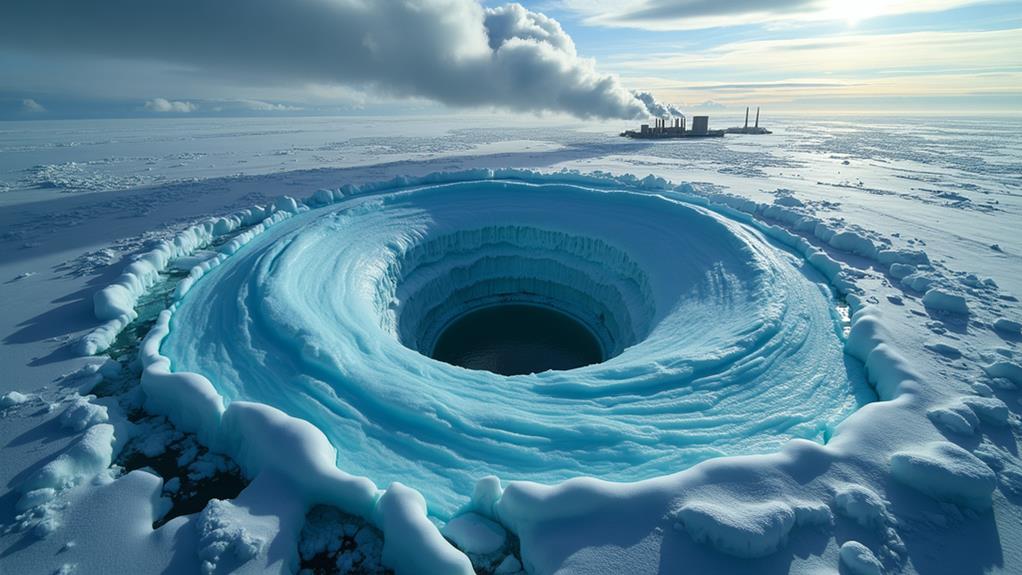
While pressure systems and the polar jet stream are vital in the behavior of a polar vortex, it's important to contemplate how climate change is altering these dynamics. As the planet warms, the polar regions are experiencing significant changes, particularly in the loss of Arctic sea ice. This loss transforms a reflective surface into an absorptive one, causing increased warming.
The warming weakens the polar vortex by reducing the temperature difference between the polar regions and lower latitudes. This destabilization leads to a more meandering jet stream, allowing cold Arctic air to penetrate further south, causing extreme weather events in regions unaccustomed to such conditions. The Arctic Oscillation, a climate pattern that influences the strength and position of the polar vortex, is also impacted by these changes.
Climate change's effects on the polar vortex are not limited to the Arctic. As the vortex weakens, the shifting jet stream brings more frequent and intense winter weather to mid-latitudes, disrupting regional climates. Future projections indicate that ongoing global warming will exacerbate these disturbances, leading to even more extreme weather events worldwide. Understanding this link helps you grasp the broader implications of climate change on our weather systems.
Historical Polar Vortex Events
Plunge into the history of polar vortex events, and you'll find a series of formidable cold outbreaks that have left a lasting mark on winter weather patterns. The polar vortex isn't a new phenomenon; it's been causing temperature plummeting cold surges for decades. Notable historical events include the severe cold outbreaks in 1977, 1982, 1985, and 1989, each showcasing the devastating impact of Arctic air descending into lower latitudes.
One standout event occurred in January 2014, when a polar vortex brought record-low temperatures to much of North America. This Arctic air outbreak led to extreme winter weather conditions, disrupting daily life and emphasizing the polar vortex's capacity to shape seasonal climates. Another significant event happened in January 2019, when the Midwest experienced severe cold winds and temperatures plummeting due to another strong polar vortex.
To highlight the recurring nature of these events:
- 1977, 1982, 1985, and 1989: Historical cold outbreaks showcasing the polar vortex's impact.
- January 2014: Record-low temperatures across North America due to Arctic air.
- January 2019: Severe cold surges affecting the Midwest with plummeting temperatures.
These historical events underscore the polar vortex's role in influencing extreme winter weather globally.
Consequences of Polar Vortex Disturbances
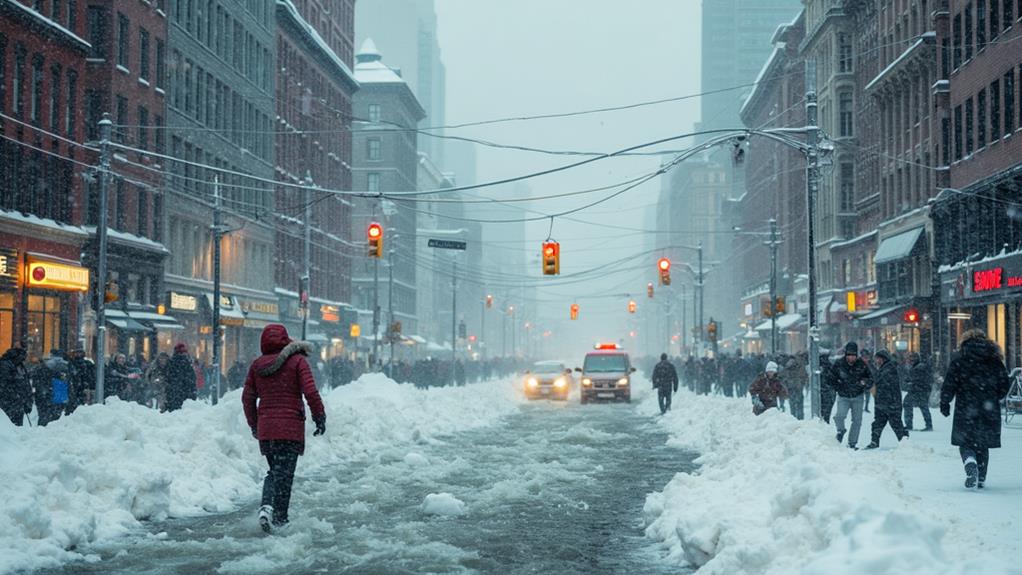
Disturbances in the polar vortex can wreak havoc on lower latitudes, causing severe winter weather events that lead to dramatic temperature drops and substantial snowfall. When the polar vortex weakens, it allows cold Arctic air to spill southward, resulting in extreme cold events. Sudden stratospheric warming (SSW) events, which destabilize the polar vortex, are often responsible for these disruptions.
For instance, in February 2021, a significant polar vortex disturbance led to record-low temperatures and heavy precipitation across multiple states in North America. You likely remember the severe cold spells and snowfall that paralyzed regions, causing widespread power outages and impacting daily life.
As these disturbances become more frequent, you can expect ongoing changes in weather patterns. January often brings the most noticeable effects, with abrupt temperature shifts and harsh winter conditions. Weakened polar vortex conditions contribute to long-term cooling trends, resulting in colder temperatures and increased precipitation.
Ultimately, these changes can lead to more extreme weather events, including heavy snowfall and sudden cold snaps. Understanding the consequences of polar vortex disturbances helps you better prepare for the unpredictable and harsh winter weather that can arise from these atmospheric shifts.
Frequently Asked Questions
What Is the Main Cause of a Polar Vortex?
You should know that the main cause of a polar vortex involves stratospheric warming and disruptions in the jet stream. These shifts affect atmospheric pressure, especially in polar regions. Climate change exacerbates these issues, leading to more frequent winter storms. Temperature fluctuations cause air masses to destabilize, influencing weather patterns. The Arctic oscillation also plays a role, as it can either contain or release cold air depending on its phase.
When Was the Last Polar Vortex?
The last polar vortex event happened in February 2021, greatly impacting Texas and the Southern Plains with extreme cold. Polar vortex history shows several impactful events, like in 1977 and 1985, each bringing unique polar vortex effects. Polar vortex terminology often confuses people, leading to myths. Research and predictions help improve our awareness. Comparing past and recent phenomena, it's clear the impacts are progressively severe, highlighting the need for ongoing research and understanding.
How Often Do Polar Vortexes Happen?
You might wonder about polar vortex frequency and how often they affect Arctic weather patterns. These events typically occur annually but vary in intensity and impact. Historical occurrences show major disruptions every few years. Winter storm impacts depend on atmospheric circulation and jet stream behavior. Climate change influence, temperature anomalies, and seasonal variations all play a role. Improved weather forecasting techniques now help predict these events and their potential severity.
Are Polar Vortex Rare?
So, you think polar vortexes are like unicorns? Not quite. Polar vortex myths aside, these meteorological phenomena aren't rare at all. They regularly occur in winter, with historical records showing them as far back as 1977. Climate change impact and Arctic warming only make temperature fluctuations more pronounced. Scientific research shows their effect on weather patterns and seasonal effects, emphasizing the need for public awareness about these cold outbreaks.

